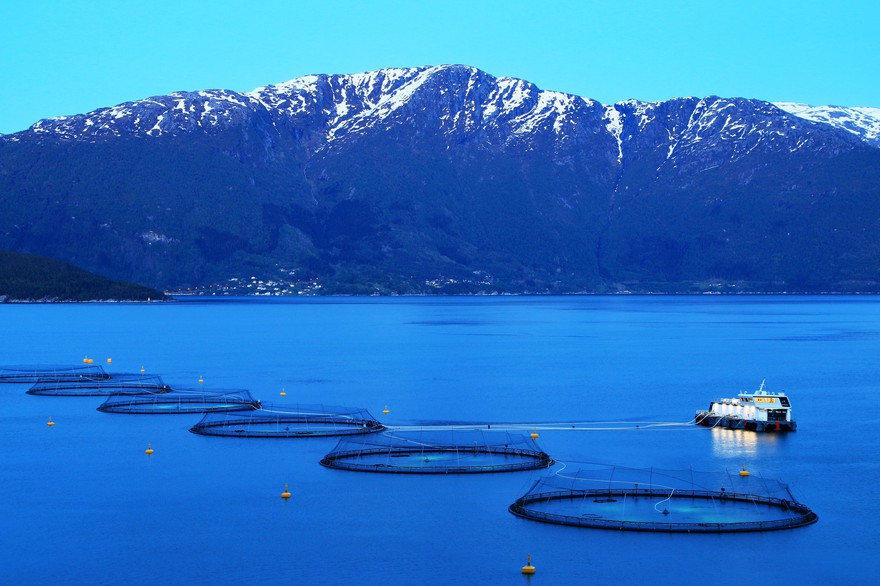
There are a lot of reasons to be bullish on the seafood industry. Fish and seafood are generally considered to be the healthiest animal proteins available. Done properly, sustainable seafood is the most environmentally efficient source of protein on the planet, according to the National Oceanic and Atmospheric Administration. It's also a consumer staple, meaning it's a relatively recession-proof product.
Some think of aquaculture companies as a form of agriculture. They cultivate fish and other sea creatures in controlled environments and have become a major industry alongside wild fisheries.
If you're looking for public seafood companies, you won't find any of substantial size in the U.S. since the domestic industry is highly fragmented. In fact, the best place to look for fishing industry stocks is Norway, which is the second-largest seafood exporter in the world behind China. That's an impressive feat for a country with a population of barely 5 million. Keep reading to see five of the top aquaculture stocks you can buy today.
Top seafood stocks in 2025
| Name and ticker | Market cap | Dividend yield | Industry |
|---|---|---|---|
| Mowi Asa (OB:MOWI) | $126.7 billion | 2.77% | Food Products |
| Lerøy Seafood Group Asa (OB:LSG) | $29.6 billion | 5.03% | Food Products |
| P/f Bakkafrost (OB:BAKKA) | $30.4 billion | 2.61% | Food Products |
| Atlantic Sapphire Asa (OTC:AASZ.F) | $25.1 million | 0.00% | Food Products |
| SalMar Asa (OTC:SALR.Y) | $8.2 billion | 3.57% | Food Products |
1. Mowi

OB: MOWI
Key Data Points
Formerly known as Marine Harvest, Mowi is one of the largest seafood companies and is based in Norway. With an estimated 20% share of the global salmon and trout market, it's the world's largest producer of Atlantic salmon.
In 2025, the company brought in 5.6 billion euros in revenue and 500,000 metric tons of fish, representing a 5.1% compound annual growth rate since 2018. Operating profits were solid as well at 758.6 million euros, showing that the company generates healthy operating margins of around 14%.
Mowi is making significant investments in technology to become more efficient. It plans to use advanced imaging technology, intelligent sensors, automatic feeding, and real-time monitoring of fish and other biomass through its 4.0 Smart Farming concept, which is rolling out over the next five years. If successful, such advances could give a significant boost to Mowi's bottom line. The company also offers a 3.5% dividend yield.
2. Leroy Seafood

OB: LSG
Key Data Points
Also headquartered in Norway, Leroy Seafood counts on salmon for more than half of its revenue, but it also does significant business in trout and whitefish. The company's revenue increased 1% in 2024 to $3.1 billion, while operating income fell slightly to $2.96 billion. Harvest volume rose in 2024 by 7.3% to 171,228 metric tons, but revenue was affected by lower prices. Historically, the company's performance has been volatile, fluctuating with factors such as fish prices. Lower fishing quotas on whitefish have also restricted the company's catch volumes recently. In 2024, catch volumes fell 14.4% to 65,000 metric tons.
Leroy is making a wide range of investments, including in land-based farming, adding new whitefish fishing vessels, and adding shielding to its fish farms and mature salmon operations. The company expects those to drive growth over the coming years. Still, the unpredictability of quotas remains a risk, and its outlook for wild catch is challenging due to lower quotas.
The company is also committed to its annual dividend, which currently offers a yield of 5.8%.
3. P/F Bakkafrost

OB: BAKKA
Key Data Points
Bakkafrost is the leading producer of high-quality salmon from the Faroe Islands and Scotland. It's officially headquartered in the Faroe Islands, which is part of Denmark. It also has vertically integrated salmon farming operations, in which it manages every stage of the process, from producing feed to value-added products like smoked salmon.
In 2024, the company generated $1.17 billion in revenue, up 5% from the previous year, though operating profit fell from $210 million to $158 million.
Harvested volumes rose by 24% to 90,656 metric tons, though prices were down modestly.
However, management continues to plan to reach 165,000 metric tons by 2028, driven by its large smolt capacity and expansion of its land-based freshwater hatchery.
Like the other seafood stocks on this list, Bakkafrost is a solid dividend payer, offering a yield of 2.8%, which is paid on an annual basis.
4. Atlantic Sapphire

OB: ASA
Key Data Points
Also headquartered in Norway, though it has major operations in Denmark and Florida, Atlantic Sapphire has one of the boldest strategies in the seafood industry.
The company is aiming to raise salmon in land-based fisheries. Typically, farmed fish like salmon are raised in marine net pens that allow seawater to circulate through them.
Atlantic Sapphire says it is the largest global land-based aquaculture company in the world, and it's innovating with its Bluehouse technology.
Bluehouse refers to its fisheries, where water is purified by state-of-the-art filtration systems, where the fish can swim against strong currents. The systems also help protect the fish from lice and wild fish diseases, and they allow the salmon to be farmed locally, making them fresher when brought to market.
The company opened its first Bluehouse in Denmark more than 10 years ago, but it's still a small company with $22.8 million in revenue in 2024. Its Bluehouse in Florida, which is currently under construction, is aiming for 220,000 tons of annual capacity.
5. SalMar

OTC: SALR.Y
Key Data Points
SalMar is one of the biggest seafood companies in the world, and one of the largest and most efficient producers of farmed salmon. Based in Norway, it also owns 52% of Icelandic Salmon, which owns 100% of Arnarlax, an Icelandic company that uses sustainable, natural methods of aquaculture.
In addition to its production in Norway, SalMar is also the second-largest salmon farmer in Great Britain.
Like some other seafood companies, Salmar struggled in 2024 as revenue and profits declined. The Icelandic unit experienced an outbreak of sea lice. Volume fell 10% in 2024 to 231.8 million tons, but management expects harvest volume to rise to 320 million tons in 2025, a significant recovery.
Like agriculture and other food-producing industries, SalMar and its peers are subject to a wide range of risks, including commodity pricing, disease, regulations, and other factors, so volatility is normal in the industry.
Related investing topics
Should you invest in seafood stocks?
Fishing is one of the oldest industries in the world, but it's also changing quickly. Technological innovations, salmon farming, and climate change all present opportunities for fishing companies on the stock market, as well as challenges. Seafood supplied from aquaculture could soon surpass wild-caught seafood in volume, and that could make a historically commodity-based industry ripe for innovative players.
Expect the expansion of farming and aquaculture to continue to drive growth in the industry in the coming years.




